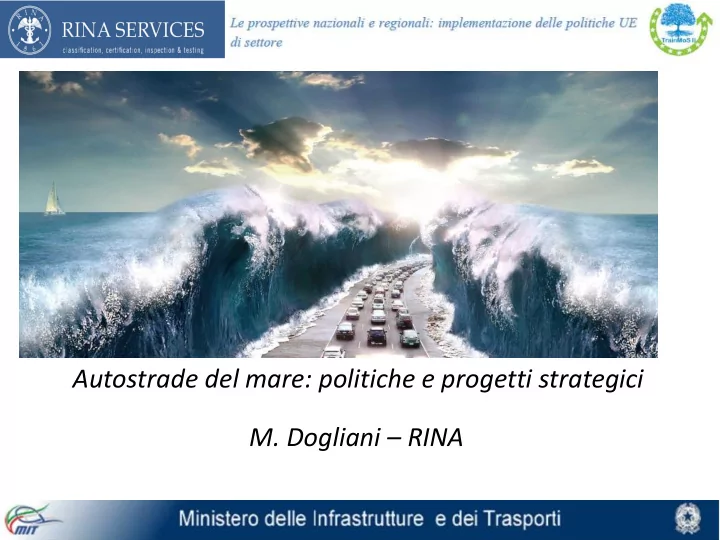

Autostrade del mare: politiche e progetti strategici M. Dogliani – RINA
MIT priorities & RINA’s role [...] # 1 “Safety” [...] # 3 “Increased Transport System Efficiency” ... use of Intelligent Transport Systems (ITS)... ... mobility management along the whole chain .... … intermodality …. ... reduced environmental impact... [...] # 4 “ Digital Administration ” ...increased use of Information Technology ... .. implementation of the Italian Law (Code of Digital Administration).. ... electronic data exchange systems leading to: - paperless administration - reduction of administrative burdern - simplification
#4 Digital Administration Reporting Formalities e-certificates EU (D65) – 2015 WORLD (IMO FAL 39) - 2019 Use of e-data by NMSW NCAs ILO’s MLC Italian flagged ships Interface able to report to NMSWs worldwide with ITS Crew skill reporting Use of e-data by trade Services to passengers Interface with PCSs Future ML2 MIELE B2MOS ANNA 2015-2020 2013 2013 2013 2010 TEN-T Projects CEF Projects
#3 Transport efficiency & sustainability Fuel emissions Other aspects EU (2014-2030) WORLD IMO (2015-2025) Sulphur (D2012/33) MARPOL ANNEX VI Alternative fuels (D2014/94) WORLD IMO (2015...) MARPOL Other Annexes Avoid shift back Energy efficiency from sea to land National Framework EU cross-border-continuity world wide cross border continuity Future COSTA GREENCRANES POSEIDON MED SEATERMINALS 2015 - 2020 2012 2012 2014 2014 TEN-T Projects CEF Projects
GAINN_IT & MALTA Sulphur cap: where & when 0,1% 2015 0,5% 2020-2025 0,5% 2020
Available ship LNG refuelling facilities (none in the Med; only via trucks) Gasnor 200 Mcm/y Existing terminals with reloading/Truck services Skangass Gothenburg 400 Mcm/y 6 Mcm/y Planned terminals with reloading/Truck services Small scale LNG production Gate 50 Mcm/y Swinoujscie LNG storage accessible for ships 130 Mcm/y Zeebrugge 1000 Mcm/y Montoir-de-Bretagne up to 0.07 Mcm/y (exp. to 0.36 Mcm/y) Musel 350 Mcm/y Fos Tonkin (up to 0.07 Mcm/y, exp. to 0.36 Mcm/y) Marmara 650 Mcm/y Barcelona 500 Mcm/y Huelva 500 Mcm/y Aliaga Cartagena 500 Mcm/y 350 Mcm/y
Can we afford the wait & see #1? +50% fuel cost + 20% waterborne transport cost shift back from sea to road 4 -10% increase congestion Road congestion in 2009 costed Italy 40 B € (3% GDP)
Can we afford the wait & see #2? WORLDWIDE SHIP TRAFFIC INTENSITY PIT STOP
Italian Alternative Fuels Network Three national grids : • Tyrrenic-Ligurian pilot LNG grid LIVORNO • South Italy pilot LNG grid • Adriatic-Ionic pilot LNG grid ‘Element’ involved: • • Genova La Spezia • • Ravenna Livorno • • Augusta Civitavecchia • • Ancona Messina • Venezia
Expected in 2020 (2014 hypotesis) LNG Bunkering ship ISO-Tank Offshore/Onshore storage Natural Gas Network + Microliquefactor Storage & ancillaries LNG fuelled ship LNG fuelled vehicles LNG refuelling for ship LNG refuelling for vehicles LNG storage system LNG receving system and/or LNG fuelled ship and/or LNG fuelled vehicles
Partners/Stakeholders
Can we afford the wait & see #3? A13 – I13 Lack of skilled seafarers Depending on the number of LNG fuelled ships in 2020/2030 the number of seafarers can be ( … ) a significant fraction of the more than 1,2 millions seafarers demanded in 2020 ( … ). The likelihood of the issue not to be solved is judged low since it will be demand driven and passage to LNG will occur gradually. The direct impact of not having the necessary workforce trained is high since it directly affects the possibility to safely operate LNG fuelled ships. The possibility to manage the issue is judged high since training programmes can be established in due time before 2020. Aspects related to this issue are: training of ashore personnel lack of training infrastructures
Recommend
More recommend